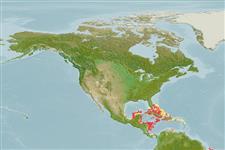Classification / Names
Nomi Comuni | Sinonimi | Catalog of Fishes(Genere, Specie) | ITIS | CoL | WoRMS | Cloffa
>
Gobiiformes (Gobies) >
Gobiidae (Gobies) > Gobiinae
Etymology: Evermannichthys: From Evermann, 1902, researcher about fauna + greek, ichthys = fish (Ref. 45335).
Eponymy: Dr Barton Warren Evermann (1853–1932) was a schoolteacher (1876–1886) and a student at Indiana University, where he was awarded his bachelor’s degree (1886), master’s (1888) and doctorate (1891). [...] (Ref. 128868), visit book page.
Environment: milieu / climate zone / depth range / distribution range
Ecologia
marino demersale; distribuzione batimetrica 27 - 30 m (Ref. 40966). Tropical
Western Central Atlantic: known from the type locality, Navassa Island. Also from the Bahamas (Ref. 92840).
Size / Peso / Age
Maturity: Lm ? range ? - ? cm
Max length : 3.0 cm SL maschio/sesso non determinato; (Ref. 92840)
Short description
Chiavi di identificazione | Morfologia | Morfometria
Spine dorsali (totale) : 6 - 7; Raggi dorsali molli (totale) : 10; Raggi anali molli: 9. Distinguished by having the following characteristics: thin and elongate in form; reduced scale cover and head pores; depth of body about 2 mm (Ref. 92840); uniformly dark on dorsal third of body and pale on remainder; clear median and paired fins; frenum connecting the upper lip to snout is reduced; separated upper lip and snout; tongue is emarginate (Ref. 44822).
Obligate sponge dwellers. Live deep within canals of the sponges, near the openings to the incurrent canals. Sponges provide species with protection from predators and an available food source in many invertebrates. Eggs found within sponge or small plankton brought through incurrent pores (Ref. 92840).
Life cycle and mating behavior
Maturità | Riproduzione | Deposizione | Uova | Fecundity | Larve
Eschmeyer, W.N. (ed.), 2001. Catalog of fishes. Updated database version of December 2001. Catalog databases as made available to FishBase in December 2001. (Ref. 40966)
IUCN Red List Status (Ref. 130435: Version 2024-2)
Threat to humans
Harmless
Human uses
Strumenti
Special reports
Download XML
Fonti Internet
Estimates based on models
Preferred temperature (Ref.
123201): 21.2 - 27.7, mean 26.5 °C (based on 42 cells).
Phylogenetic diversity index (Ref.
82804): PD
50 = 0.5312 [Uniqueness, from 0.5 = low to 2.0 = high].
Bayesian length-weight: a=0.00724 (0.00339 - 0.01546), b=3.10 (2.92 - 3.28), in cm total length, based on LWR estimates for this (Sub)family-body shape (Ref.
93245).
Trophic level (Ref.
69278): 3.1 ±0.3 se; based on size and trophs of closest relatives
Resilienza (Ref.
120179): Alto, tempo minimo di raddoppiamento della popolazione meno di 15 mesi (Preliminary K or Fecundity.).
Fishing Vulnerability (Ref.
59153): Low vulnerability (10 of 100).
